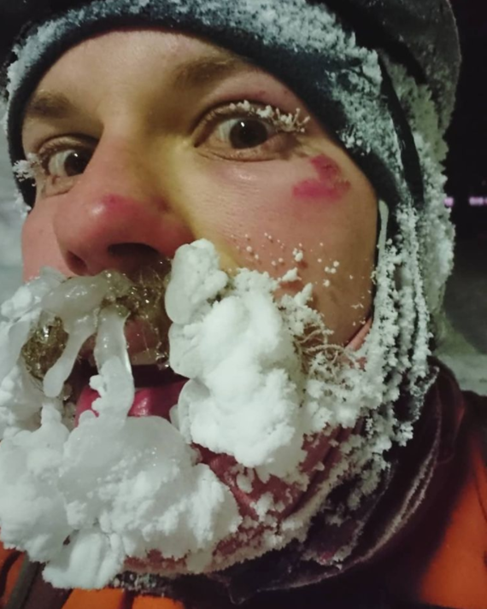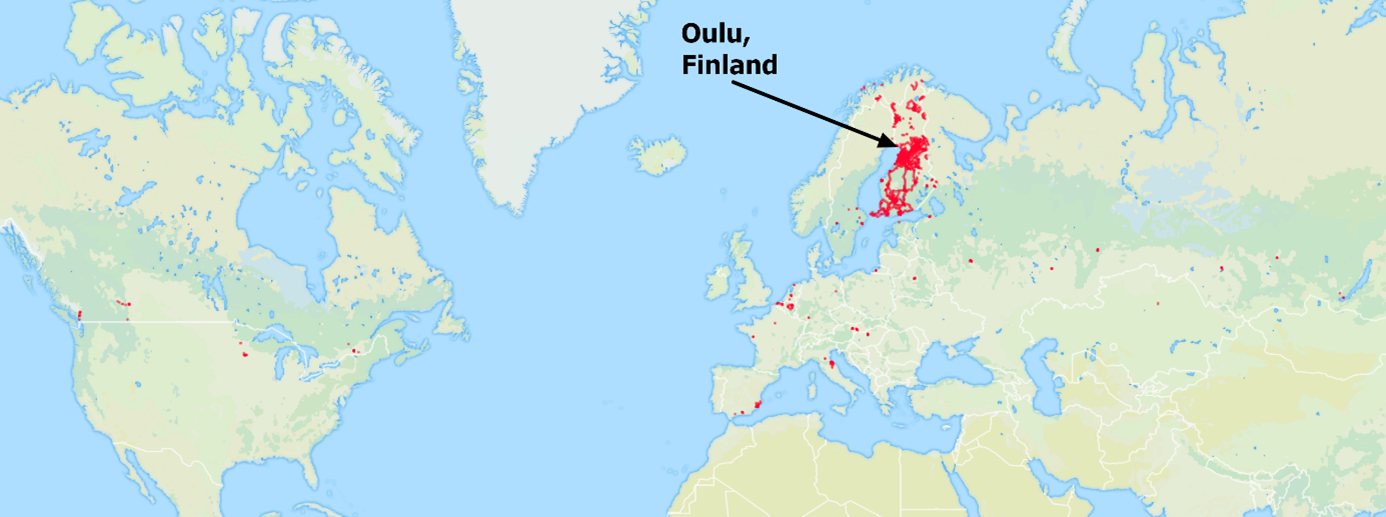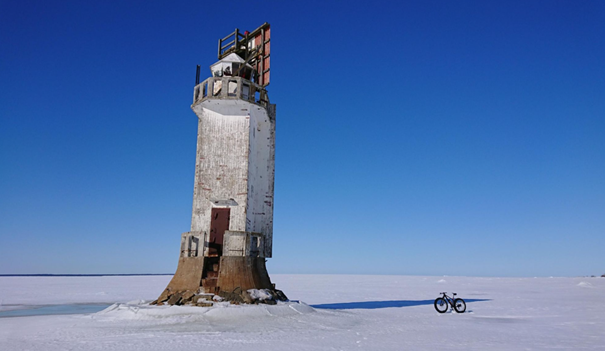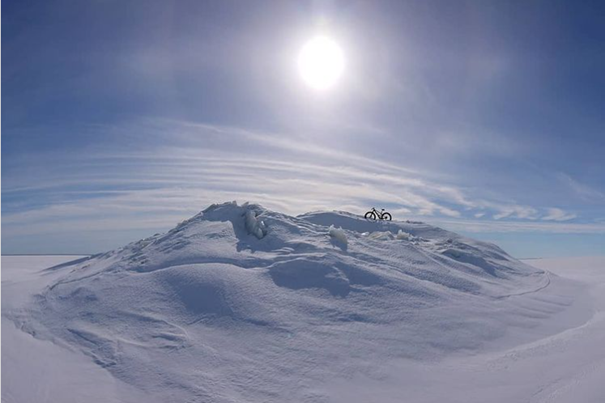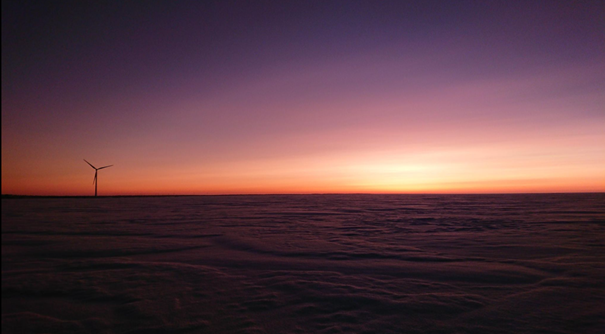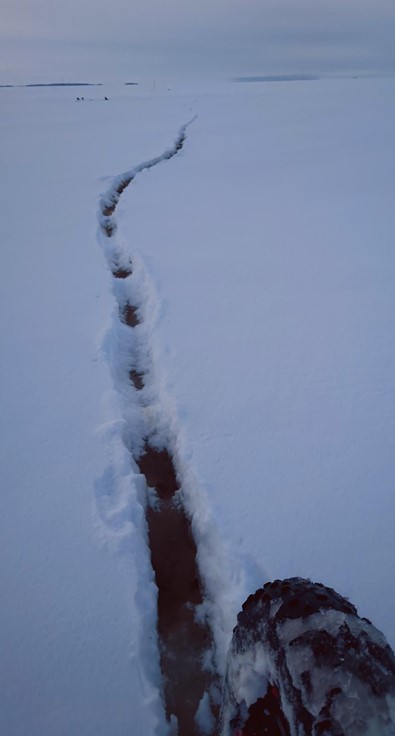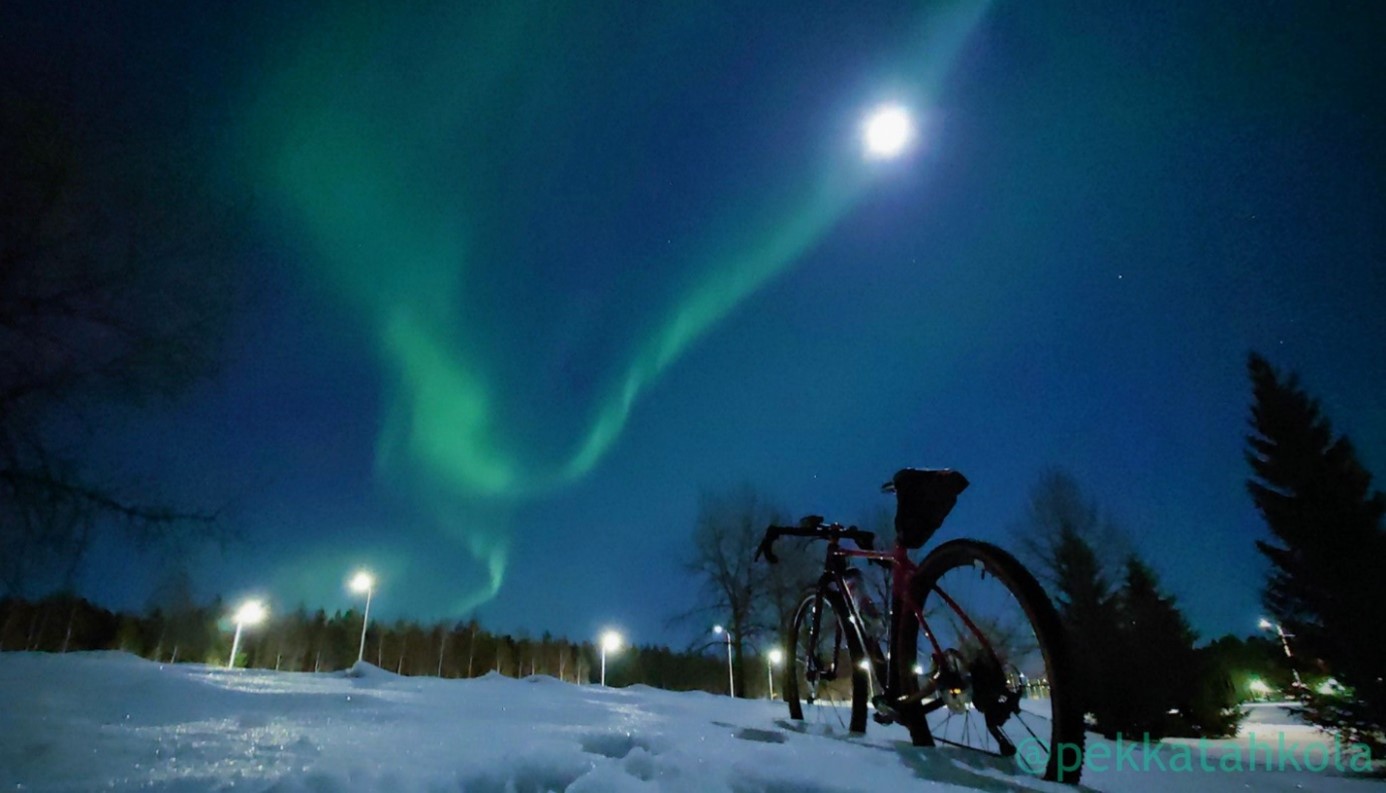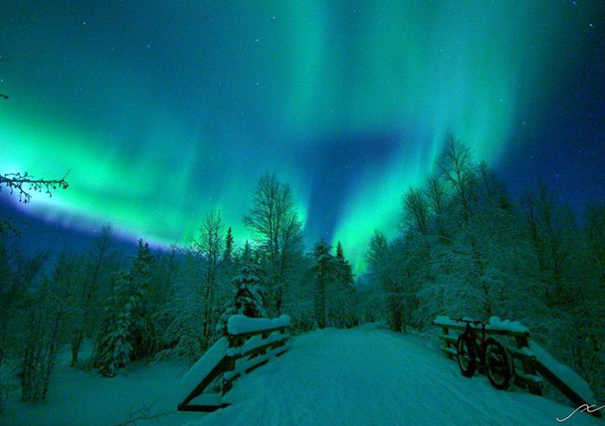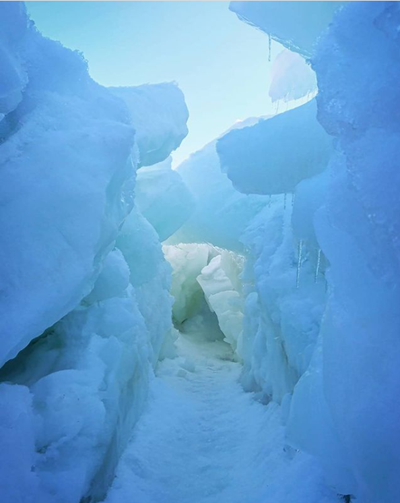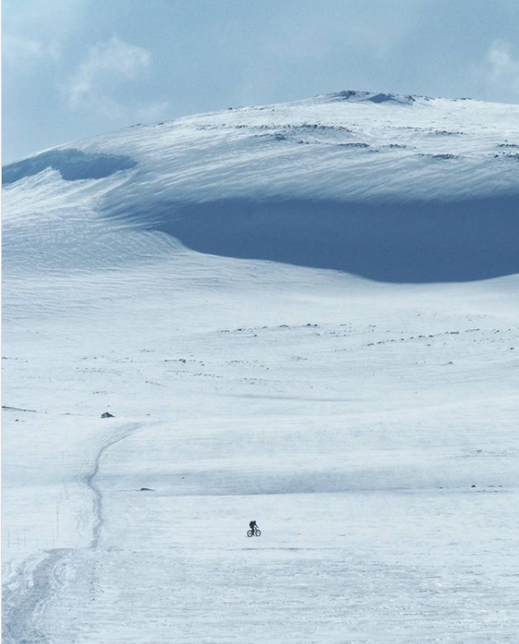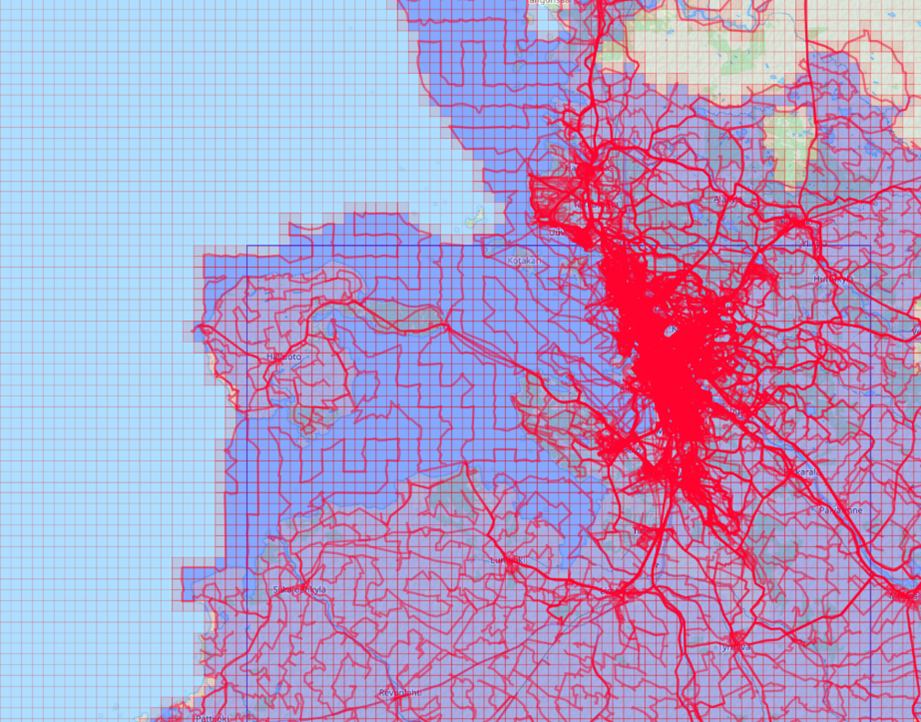Yorick Dix's tiler interviews: Pekka Tahkola tiling the Arctic
Q. Hello Pekka, could you please introduce yourself?
I'm 39 and I'm an urban well-being engineer focused on even further improving the everyday cycling and walking conditions here in Oulu, Finland. We're on 65th latitude, so almost at the Arctic Circle. Oulu is by far the world's best city when it comes to cycling in winter because of excellent infrastructure and winter maintenance, so pretty much everyone rides everywhere here in winter as well. Sure, I personally do take it a bit to the extremes sometimes ;)
Q. And what does a 'urban well-being engineer' do for a living?
In short, for my work I'm trying to make this world a more cyclable and walkable place. Promote wise mobility (electric cars are not that). Making cycling and walking fast, easy and comfortable, so that it makes people go out, use their own muscles to move about, to run their daily errands wisely and try to minimize 'stupid' mobility (mostly cars). You probably already understand the health benefits of cycling and walking, but they are immense. Good bicycle infrastructure and maintenance are some of the most effective preventive healthcare. Both physically and mentally. Walkable and cyclable environment is pleasant, safe, socially safe, clean from pollutants, noise and stress and so on. Not to even mention how much more cost-effective it is, especially for our economy. All in all, it means wellbeing for everyone.
In addition to bicycle and foot traffic, marketing those, creating strategies, education and even online courses, I also plan mountain biking, hiking, bike packing etc. routes and services. Those possibilities here in the beautiful north are just endless. And you can find more information on my Twitter profile
Q. When and why did you start tiling?
I've always used my bike to go places, and later on the distances and areas covered grew bigger. I've only joined Strava in late 2015 and before that I didn't record almost any tracks so I didn't have much of a backlog to benefit from. In October 2017 I found out about VeloViewer and the whole tiling thing, and I was sold right away. I have already always wanted to "conquer" the world by visiting as many places as possible and now it was kinda possible to play a real-world game about it, and I immediately started.
The first ride that mentions tile hunting is dated on 27th Oct 2017. I remember at some time Nils Oudejans and Dominique were dominating the charts back then and they were kinda my idols 😊. I actually had the honor of meeting both of them during my one-week bike trip in Belgium a couple of years ago.
Q. You have a decent cluster (6400+ tiles) and square (58x58), but the amount of visited tiles is enormous compared to it, 24,000+. Did you make long trips around the world?
Not that much. My longest biking trips are still all below 10 days and most of them within Finland. I also had a working trip to Belgium where I managed to do a few days of bikepacking and to also meet Nils and Dominique.
Also, the tiles are smaller here in the north. About 1050 x 1050 meters at this latitude. Yes, it makes tiling a bit faster. But in contrast, once you get out of the few small urban areas, there's often just nothing. Absolutely nothing. It's not that easy to grow your cluster square once you leave the urban area, and that covers here maybe a square of 12x12 and a cluster of say 600. Outside, there are very few roads or even tracks or trails. Of course, some, sure. And many of the smaller tracks or even roads in the wilderness are impassable during winter. So, you must bushwhack a lot. Go through streams, swamps, forests, old roads that no one uses anymore and are impassable because of the vegetation etc. In 2021 I only did four rides on a regular road bike; all my other rides were mostly on my fat bike.
I recall someone from Belgium said they can average 26-28 km/h when tiling. I can average maybe 12 km/h. Sometimes even less, sometimes more. Anyway, these are even better and even more fascinating adventures. Wouldn't want to switch with anyone.
I've had a fair number of trips to various places when I traveled around the world, from western Canada to Siberia talking to cities about how to embrace cycling in winter conditions, and often had a chance to cycle around a bit. But those do not account to that many tiles, more like wonderful experiences.
Q. Did the way you tile change over time? Were you a fanatic from the start?
Not really that much has changed. I've of course learned a lot from mistakes and experience and the planning is probably a bit better organized now, as with the tools as well. Tiling didn’t really change the way I cycle, since the tiles that are located around the "normal" everyday rides have been collected years ago. But when I'm in new places, cities etc. where I haven't visited before, I always look for chances to collect a couple of extra tiles and Wandrer.earth kilometers.
I don’t really have goals in tiling. Mostly to expand my square and cluster when I feel like that and to explore new places. No stress about it. I had a long-time goal of connecting my Oulu and Syöte clusters but that's completed now. Syöte is a wonderful national park and mountain biking and hiking resort some 140 km from Oulu where I live.
Q. You have cycled extensively on a frozen sea. The pictures are very beautiful, how was that experience? How thick is that ice? And is that in any way dangerous? Or is it common amongst the people of Oulu?
The ice (when ridable) of the Gulf of Bothnia can be anything from 5 cm to one meter thick. The thickest ice could carry a 60-ton truck and there's even a 7 km official ice road sometimes open between a nearby island municipality and Oulu when the conditions are good. But yes, you really, really must know what you're doing. Even if we've got 50 cm of ice in one place, it could still be very thin or even open water right nearby. There are certain places that stay open year-round because of currents or different shapes of sea bottom and you need to have the knowledge about those. It’s no joke. On longer ice trips, I always have spare clothes packed waterproof, ice picks / ice claws to help climbing back on ice if I happen to fall through, and of course something to float me in addition to my fat bike (which also floats, that is tested 😉).
The greatest and the worst challenge for me to expand my max square are the ice breaker ships. They keep open three passages for cargo ships round the year and crossing them to get to the other side, to expand my max square has so far been impossible. Theoretically, those passages freeze again in a couple of hours when it's cold enough, say -25 to -35°C, but that's almost a suicide. If you fall in, you are dead. The passages can be 200 meters wide and can look like war zones with huge several meter ice chunks all pointing in different positions and you never know when you fall through. I've thought so much about how to safely cross them and maybe some day I will find a way. But I would also like to stay alive :-). You can see some photos (on a too warm day) in this ride
I would say never ever go alone, but usually no one is crazy enough to follow me so I too often have to go alone. Don't try this at home!
Some local people do also cycle on the frozen sea a bit, mostly just really close to the shore and that’s usually very safe. Lots and lots of people ski and go ice fishing, that's much more common. The ice conditions are in no way a piece of cake. The ice collects huge layers of snow that most of the time makes cycling totally impossible even with a fatbike. So, the most of any winter, riding any further on the sea is just impossible because there's so much snow. The weight of the snow also presses the ice down, making it sometimes crack, and that's when water gets on top of the ice and under snow. That can sometimes be quite scary as well.
You need to follow the conditions, weather forecasts, ice conditions. During winter they update the ice conditions map daily, mostly because of sea ship operations. Wind is something to consider. You have absolutely no shelter on the ice and it can be really, really cold. But when you know what you're doing and know how to prepare, the experience is just out of this world. It's so beautiful, silent, magical I'd say. And to experience the Aurora borealis, a sunset or sunrise over there, can't even describe it 😊.
Q. I've read that you cycled with temperatures of -28 degrees Celsius, what special gear do you use to keep warm? Are there any bears around to be afraid of?
I've cycled in -41°C under magnificent northern lights. I would also love to cycle in even colder conditions, but I haven't yet been lucky enough to meet with such.
Even though I absolutely love cold weather and proper winters and would never want to move to a warmer climate, the cold and its dangers of course need to be taken seriously. It's a bit difficult to find SPD shoes that would keep you warm and gloves that would allow even some functionality. I don't like pogies / bar mitts, but those would help with the hands. And you could use flat pedals and warmer winter boots with no cleats, but I don't like those either on the adventures. In addition to the regular Lake 303 and 400 shoes that are sized up to allow extra soles and socks, I do have custom handmade Siberian SPD shoes that are quite good to about -30°C and I will survive with them even below -40°C. But in case your toes are beginning to feel too cold, just run a minute or two and you're good for another 30 mins or so. And I mean run, like run for your life, that makes your warmer blood flow all the way to your toe tips. If you walk or just casually jog, it takes much longer time.
I've never used any electric or chemical warmers when riding but they can be a good backup in case something happens. And if you want to use any of them, just go ahead. Anything that makes you go outside 😊. There are no bears here in my city, but there are some bears, wolves, wolverines, and other lovely animals in the wilderness. And hundreds of thousands of reindeer. I've only ever seen bear footprints a few times, but I'm 100% sure they have seen me several times. It's indeed quite rare to see one in the wild, but it's possible. If you see one, just slowly walk away and usually it will be fine.
Q. It must be potentially very risky to have a relatively innocent accident or even a flat tire. Do you take special precautions?
If it's really cold, of course you need to have some extra spare clothes with you if something happens. It's indeed no fun trying to fix a tubeless flat in -30°C indeed. Luckily that's only happened once, knocking on the wood 😉. In addition to matches to make fire if needed, I also often carry a couple of small chemical warmers in the backpack just in case. Never had to use them so far though.
Q. What do those temperatures do to your bike? All that snow and ice, that must be slippery? Do they use salt on the road?
Nothing special happens really. When it's extremely cold, some plastic parts could crack but you shouldn't have that kind of parts in your bike anyway. Ice can be slippery yeah, but snow isn't. I only have one bike with studded tires installed on it, but I never need to use it because the winter maintenance here in Oulu, Finland is so good. We do not allow salt on bike paths here at all, that would destroy the bikes, the environment and so on. Instead, we plow the paths properly with a tiny, toothed blade, producing a perfect surface to cycle on even on a granny bike with summer tires. And only if it gets too icy, then we add a small amount of sand and small bicycle tire friendly gravel to add friction. Works perfectly.
Q. Do you have a special tile of which you have special memories? Any tile which took extraordinary efforts to reach?
On this ride I went for one tile surrounded by two icebreaker paths and of course those paths can slightly vary in location even during the same winter. I was soooo close to get it and I finally managed to reach it (not too safely though!). But during this ride I did have a friend with me to help if something would happen. Should probably have had a rope as well or something. Also there are a couple of really hard-to-get tiles right next to the city center in a closed oil harbor and pulp mill area, but it's technically possible to collect them cycling on a frozen river right next to the shore. You need to be really careful there as the river current is strong and keeps the water flowing and open from ice even in -30°C.
Q. Tiling brings us to the most beautiful and weird places. What did you discover because of tiling, what you otherwise never have known?
There is so much, don't even know where to start. For example, the Corner of Death. This area on the sea is literally named Kuolemannurkka - "The Corner of Death". Or Käsivarren erämaa, it is one of the most remote and untouched places in the whole of Europe. You feel so alone, small and vulnerable. And most of all, so alive. It was an amazing adventure - this is what fat bikes are for!
In addition to the frozen sea adventures, the so-called snow crust adventures are a world of their own. Sometimes in the springtime it might happen that the warmth of the sun starts to melt the cover of the snow, and during the night it freezes again. Next day, same thing over and over. If and only if that cycle happens many times enough, the surface of the frozen snow might be strong enough for you to cycle anywhere. I mean anywhere. And those special conditions allow you to collect again otherwise totally impassable tiles on large swamps for example. Also, you need to be really early for those. I sometimes start riding at 3 am or so, because the daylight might again melt the surface, and trust me, it’s no fun trying to somehow try to crawl several kilometers back to roads from the wilderness, if your every single step falls through a meter of snow with a great probability of water and wet swamp underneath. If possible, these adventures are even more amazing than the frozen sea trips.
Here I was (Instagram; enable sound) on a morning in a misty sunrise on a frozen otherwise totally impassable swamp where even walking would be impossible any other time of the year.
Q. Are you ever fed up with tiling? Have you ever cancelled rides when already started?
Never happened. I do plan rides that have a huge number of tiles just in case I would have enough time, but often times it can happen I simply run out of time and have to stop because of that. Never fed up as of yet.
Q. What extraordinary feats of other tilers did you notice?
Jonathan's 100x100 in one year was just mind-blowing! Also those several one ride max square of several riders are really impressive. And I must not forget all the climbing Jürgen has done (250,000 vertical meters of ascent in 2021 alone), in addition to his cluster now reaching from the Baltic Sea to the Mediterranean.
Q. In your surroundings, has anyone started tiling because of you?
Almost everyone who does tiling around here probably started because of me, and there are many more to come. As I organize lot of events and work with cycling-related things, a lot of people know me and know about my crazy and stupid adventures so I guess it's mostly word-of-mouth. I also like to participate and organize group rides. Also, I'm sometimes somewhat active in social media.
The people here know quite well how to ride on ice and where to go and where to not go. I don't see that as a risk. And you can still get a decent square and cluster here without going on the ice at all, if you don't want to. As they've heard of and seen photos and videos of my adventures, they can easily judge it themselves if they want to try something like that or not. Nowadays most people in our events and group rides have already heard of tiling, so I can pretty much only tell them how it's really like, and I of course try to be honest about it.
Q. Any ideas on the whole concept of tiling? Any possible improvements you are thinking of?
I really like the way it is now. Maybe to make it a bit more accessible to larger audience there could be an app for that or something, don't know. But then again, I'm not sure if tiling really needs that.
Q. In whose story would you be interested?
Yours! I understand you have asked someone to interview yourself, I look forward to reading that. I also like the cluster playfight of you and Jürgen.
Pekka's vital statistics
Max square : 58 (leaderboard data)Max cluster : 6406 (leaderboard data)
All tiles count : 24593 (leaderboard data)
Rarity weighted : 0
Average tile rarity : 0
Home region: Finland
Pekka on Strava
Pekka on Veloviewer
Pekka on Instagram
Pekka on Twitter
